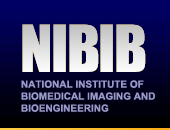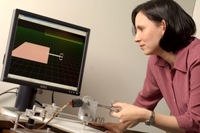Home > News and Events > NIBIB Newsletter 
In This Issue
LinksNational Institute of Biomedical Imaging and Bioengineering (www.nibib.nih.gov) Contact UsScience Highlights
NIBIB Grantee Adds Feeling to Robot-Assisted SurgeryRobot-assisted surgery means patients experience less pain and scarring, reduced bleeding, and faster recovery times, but surgeons can not feel what they are doing the way they can when performing conventional surgery. To overcome this challenge a Johns Hopkins University research team is developing two approaches: One provides visual cues to the surgeon depending on how much force is used, while a second method involves design of force sensors that deliver direct tactile feedback to the surgeon. To learn more about the work of Dr. Allison Okamura and other NIBIB grantees, please visit www.nibib.nih.gov/HealthEdu/eAdvances. Funding Opportunities & UpdatesBridge Funding for New InvestigatorsInterruption of funding for new investigators because of unsuccessful first R01 renewal applications can have a significant negative impact on the research. In order to address this potential interruption in funding, NIBIB has established a bridge funding policy for applications that are close to the funding payline. Effective the first Council round of FY 2007, bridge funding is available to applicants who meet the following criteria:
The bridge funding will be provided as a one-time-only occurrence for one additional year at the funding level for the last year of the current grant. If the applicant receives funding of the competing renewal through the select pay mechanism or as a result of movement of the payline, the bridge funding will be integrated as part of the budget for the competing renewal award. Additional information is available at: www.nibib.nih.gov/Funding/Strategies/NewInvesBridge. Names in the News
Leapman Named Scientific DirectorThe National Institute of Biomedical Imaging and Bioengineering (NIBIB) has appointed Dr. Richard Leapman as the Scientific Director of its Intramural Research Program. As Scientific Director, Dr. Leapman will be responsible for planning, evaluating, and directing all aspects of NIBIB’s intramural research. Prior to his appointment at NIBIB, Dr. Leapman was Acting Director of the Division of Bioengineering and Physical Science in the Office of Research Services at NIH. He served in a dual capacity as Chief of the Supramolecular Structure and Function Resource. Dr. Leapman received his Ph.D. in physics from the University of Cambridge, England. Dr. Leapman’s research interests are in the development and application of quantitative electron microscopy and the application of novel nanoscale imaging methods to solve problems in structural and cellular biology. He has been particularly active in developing the techniques of electron energy loss spectroscopy (EELS) and combining it with x-ray spectroscopy and scanning transmission electron microscopy (STEM) to provide an unprecedented high spatial resolution for nanoanalysis of biological structures. Dr. Leapman has devised new methods for quantifying both elemental and chemical information obtained from inelastic electron scattering, a research area in which he has more than 100 peer-reviewed publications. Dr. Leapman is the recipient of numerous awards including the Burton Medal from the Microscopy Society of America, the Samuel Wesley Stratton Award from the National Institute of Standards and Technology, and two NIH Director’s Awards. He is currently serving as editor of the Journal of Microscopy. McLaughlin Appointed Director of the Division of Applied Science and TechnologyDr. Alan McLaughlin has been appointed Director of the Division of Applied Science and Technology (DAST) at the NIBIB. His portfolio includes magnetic resonance imaging (MRI) and magnetic resonance spectroscopy (MRS). Dr. McLaughlin’s background is in physics, biophysics, and physiology, and he has held academic positions at Oxford University (Biochemistry Department), Brookhaven National Laboratories (Biology Department), and the University of Pennsylvania (Biochemistry/Biophysics Department), and in the intramural programs of the National Institute on Alcohol Abuse and Alcoholism and the National Institute of Mental Health, both at the National Institutes of Health. Dr. McLaughlin’s early research focused on the use of magnetic resonance techniques to study the structure and function of enzymes and membranes. However, for the last 20 years his research focus has been on the development of novel MRI and MRS approaches that can be used to quantitate and image physiological function (for example oxygen consumption and blood flow) in live animals and humans. He received his undergraduate training in physics at the University of British Columbia, and his Ph.D. in biophysics from the University of Pennsylvania. Dr. McLaughlin has over 90 publications and has served very effectively as the lead on roadmap activities and trans-NIH activities in molecular imaging. New Faces at NIBIBDr. Zohara Cohen joined the Division of Discovery Science & Technology as a Program Director for Biomedical Informatics in October 2006. Dr. John Hayes joined the Office of Scientific Review as a Scientific Review Administrator in October 2006. Dr. Karen Peterson joined the Office of the Director as a Senior Advisor in October 2006. Ms. Monica Radford joined the Office of the Director as the Executive Assistant to the Deputy Director in October 2006. Dr. Albert Lee joined the Office of Extramural Science Programs as a Health Scientist Administrator responsible for Integration of Physical and Life Sciences in November 2006. Dr. James Xiao-zhong Luo joined the Office of Extramural Science Programs as a Health Scientist Administrator responsible for Bioinformatics in November 2006. Ms. Pam Glikman joined the Office of Research Administration as an Assistant for Council in December 2006. Ms. Katie Serrano joined the Division of Discovery Science & Technology as a Biomedical Engineer in December 2006. Dr. Rosemarie Hunziker joined the Division of Discovery Science & Technology as a Program Director for Tissue Engineering and Regenerative Medicine in January 2007. Mr. Joe Mosimann was named Acting Director of the Office of Financial Management in January 2007. Ms. Shirley Coney-Johnson joined the Office of Science Policy and Public Liaison as a Policy Analyst in February 2007. Dr. Valery Gordon joined the Office of Research Administration as a Senior Extramural Policy Officer in February 2007. Dr. Lori Henderson joined the Division of Discovery Science & Technology as the Program Director for Biomaterials, Drug and Gene Delivery and Medical Devices in February 2007. Conferences & MeetingsJanuary Advisory Council MeetingThe National Advisory Council for Biomedical Imaging and Bioengineering met on January 26, 2007, in Bethesda, Maryland. Minutes of the meeting will be available in the near future at www.nibib.nih.gov/About/AdvisoryCouncil/Meeting. Save the Date - June 1, 2007National Institute of Biomedical Imaging and Bioengineering's Fifth Anniversary Symposium: Changing the World's Healthcare Through Biomedical Technologies Upcoming Meetings and ConferencesNational Advisory Council for Biomedical Imaging and Bioengineering Society of Nuclear Medicine Annual Meeting 12th Annual CyberTherapy 2007 Conference: Transforming Healthcare Through Technology The NIH CornerNIH Fiscal Policy for 2007 Grant AwardsDue to an increase in the number of applications to its grant programs at a time of flat budgets with no inflationary adjustments, NIH is taking proactive steps to manage its portfolio of investments in biomedical research. On December 15, 2006, NIH released a notice (NOT-OD-07-030) to provide guidance to the extramural community about NIH’s Fiscal Operations Plan for FY 2007. The guidance in the fiscal policy highlights:
NIH Director’s New Innovator AwardNIH Director Elias A. Zerhouni, M.D., recently announced a special program to fund new investigators. The purpose of this program is to stimulate highly innovative research and provide support to promising new investigators. New investigators may have exceptionally innovative research ideas, but not the required preliminary data to fare well in the traditional peer review system. This new program offers grants of up to $1.5 million in direct costs over 5 years to new investigators who have not yet obtained an NIH R01 or similar grant. Applicants must hold an independent research position at an institution in the United States and must have received a doctoral degree or completed a medical internship and residency in 1997 or later. The New Innovator Award program complements the more traditional R01 mechanism, which continues to be the primary source of funding for new investigators. Detailed information on the NIH Director’s New Innovator Award is available at: grants.nih.gov/grants/new_investigators/innovator_award/. From Capitol HillNIH ReauthorizationOn January 15, 2007, President George W. Bush signed the NIH Reform Act of 2006. In a subsequent statement, NIH Director Dr. Elias Zerhouni said the Act “…affirms the importance of NIH and its vital role in advancing biomedical research to improve the health of the Nation.”
Additional information on the NIH Reform Act of 2006 can be found at www.nih.gov/about/reauthorization/. NIH Budget for FY 2007The President signed the “Revised Continuing Appropriations Resolution, 2007” on February 16. This measure provides funding for agencies that did not have enacted appropriations bills for FY 2007, including the NIH. The funding resolution includes a $620 million increase above the FY 2006 funding level for NIH. The NIBIB appropriation for FY 2007 is $296,810,000. The resolution also appropriates $483 million for the Common Fund, $69 million for the National Children’s Study (a $58 million increase), $91 million to support new investigators, and increases in research programs for the National Library of Medicine ($5 million), health disparities research ($4 million), and research resources ($34 million). |
 |
 |
Department of Health and Human Services |
 |
National Institutes of Health |
 |





